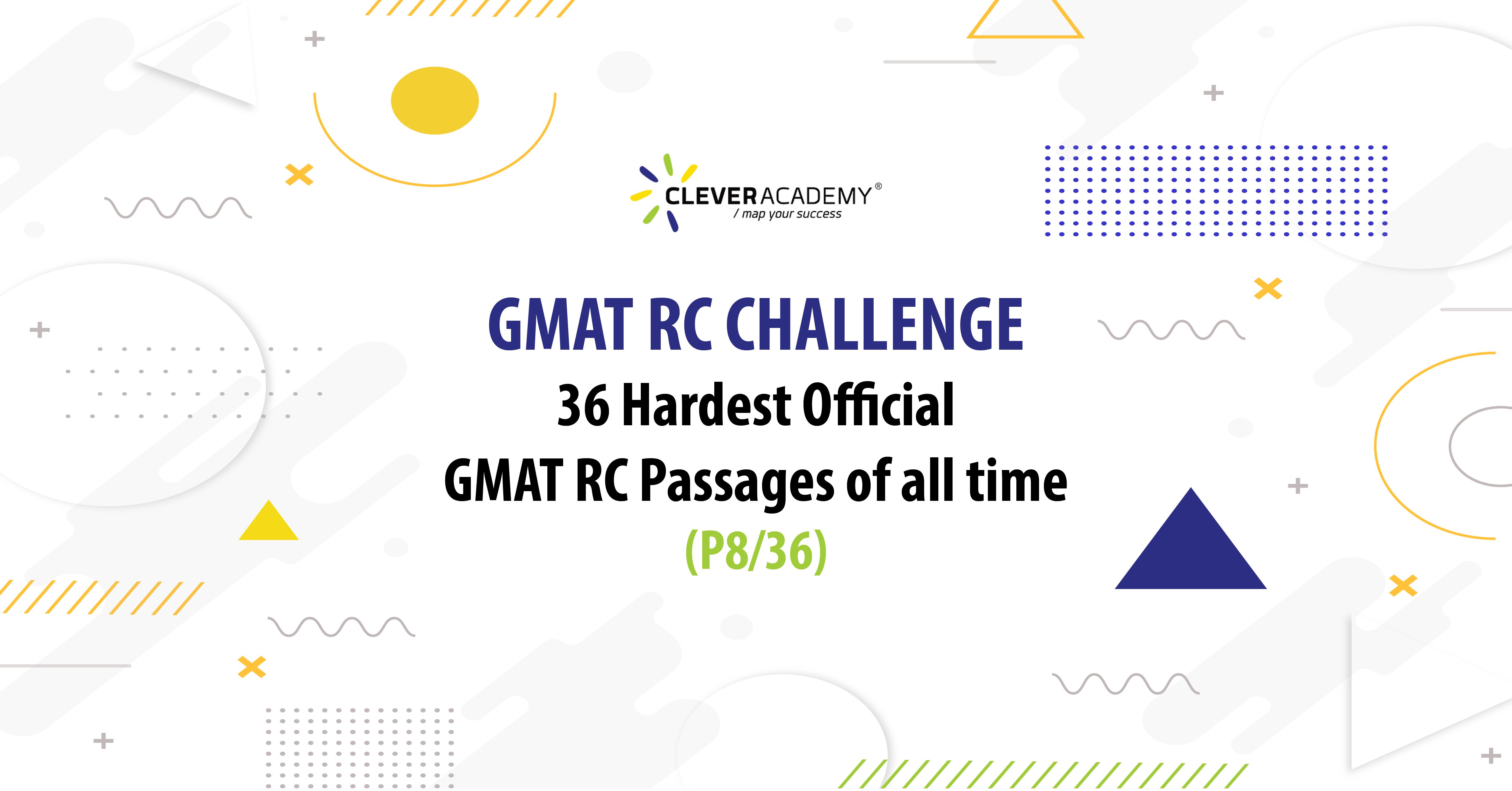
Tiếp tục series 36 hardest GMAT RC passages, hôm nay chúng ta hãy thử sức với bài đọc số 8 nhé.
Để đạt được hiệu quả tối đa khi đọc bài chia sẻ này, các bạn vui lòng:
Bước 1: Vào link gmatclub để làm bài đọc
Bước 2: Check lại đáp án của mình với quick explanations tại bài viết này
Passage 8/36: Conodonts, the spiky phosphatic remains (bones and teeth composed of calcium phosphate) of tiny marine animals that probably appeared about 520 million years ago, were once among the most controversial of fossils.
Table of Contents / Nội Dung Chính
RECAP các bước làm bài
Bước 1: Đọc bài đọc và dừng lại vài giây tóm tắt ý chính ngay sau mỗi đoạn nhỏ
Bước 2: Phát biểu Main Point / Primary Purpose hay nội dung chính của bài
Bước 3: Đọc câu hỏi, xác định vị trí liên quan trong Passage và Pre-think đáp án (Tuyệt đối không đọc đáp án trước, trừ khi câu hỏi không gợi ý được ta cần xem lại phần nào trong Passage HOẶC bạn đã nhớ rõ Passage như in)
Bước 4: Đọc nhanh answer choices và chọn đáp án gần với Pre-think nhất
Bây giờ, chúng ta cùng giải Passage 8/36 nhé!
Đáp án Passage 8/36
Summary
Para 1: The 1981 discovery — of conodont remains along with conodont fossils — has had important implications for hypotheses about the vertebrate skeleton
Cụ thể:
- Both the nature of the organism / tiny soft-bodied animals to which the remains belonged and the function of the remains were unknown.
- However, since the 1981 discovery of fossils preserving not just the phosphatic elements but also other remains of the tiny soft-bodied animals (also called conodonts) that bore them, scientists’ reconstructions of the animals’ anatomy have had important implications for hypotheses concerning the development of the vertebrate skeleton
Para 2: Two opposing hypotheses about the vertebrate skeleton –> Traditional view = defensive development + Paleontologists’ view = predators
Cụ thể:
- The vertebrate skeleton had traditionally been regarded as a defensive development, champions of this view postulating that it was only with the much later evolution of jaws that vertebrates became predators = Traditional view cho thấy vertebrate skeleton is a defensive development (sau này, jaws tiến hóa / phát triển thì vertebrates mới trở thành predators)
- Other paleontologists argued that many of the definitive characteristics of vertebrates, such as paired eyes and muscular and skeletal adaptations for active life, would not have evolved unless the first vertebrates were predatory. Teeth were more primitive than external armor according to this view, and the earliest vertebrates were predators = Opposing view / Paleontologists’ view cho thấy vertebrates là predators (vì một số đặc điểm như paired eyes hay muscular and skeletal adaptations sẽ không phát triển nếu tụi nó không phải là predators)
Para 3: New evidence (built from 1981 discovery) support paleotologists’ view
Cụ thể:
- The lack of any mineralized structures apart from the elements in the mouth indicates that conodonts were more primitive than the armored jawless fishes such as the ostracoderms.
–> Conodonts xuất hiện trước armored jawless fishes such as the ostracoderms.
- The stiffening notochord along the back of the body, V-shaped muscle blocks along the sides, and posterior tail fins help to identify conodonts as among the most primitive of vertebrates.
- It now appears that the hard parts that first evolved in the mouth of an animal improved its efficiency as a predator, and that aggression rather than protection was the driving force behind the origin of the vertebrate skeleton.
–> Conodonts = Earliest vertebrates có vẻ là predators (paleontologists’ view)
Main point: Two hypotheses about the vertebrate skeleton. Support paleontologists’ view that the earliest vertebrates were predators.
Notes: Các bạn nên lưu ý, 2 giả thuyết ở para 2 đã có trước 1981 discovery rồi từ discovery này người ta mới xem xem giả thuyết nào hợp lí hơn. Bạn có thể nhìn Tenses được sử dụng như ở cuối para 1 người ta dùng have had important implications … và ở nguyên para 2 người ta sử dụng traditionalists argued hay other paleontologists argued
Câu 1: According to the passage, the anatomical evidence provided by the preserved soft bodies of conodonts led scientists to conclude that
Prethink: Ở para 3 ta đã có kết luận về vấn đề này
- Conodonts xuất hiện trước armored jawless fishes (1)
- Earliest vertebrates were predators (2)
Ngoài ra, ở para 2, ta có được nhắc đến về teeth của vertebrates theo traditional view như sau:
- these animals developed coverings of bony scales or plates, and teeth were secondary features, adapted from the protective bony scales. Indeed, external skeletons of this type are common among the well-known fossils of ostracoderms, jawless vertebrates that existed from approximately 500 to 400 million years ago. (nhưng qua para 3 ta thấy kết luận (1) ở trên)
Vậy đáp án đúng là D. primitive vertebrates with teeth appeared earlier than armored vertebrates
Câu 2: The second paragraph in the passage serves primarily to
Prethink: Two opposing hypotheses about the vertebrate skeleton –> Traditional view = defensive development + Paleontologists’ view = predators
Vậy đáp án đúng là E. present the two sides of the debate concerning the development of the vertebrate skeleton
Extra notes:
A . outline the significance of the 1981 discovery of conodont remains to the debate concerning the development of the vertebrate skeleton (para 2 chủ yếu muốn giới thiệu 2 hypotheses) –> Loại
B . contrast the traditional view of the development of the vertebrate skeleton with a view derived from the 1981 discovery of conodont remains (hai giả thuyết thật ra đã có trước discovery năm 1981 rồi) –> Loại
Câu 3: It can be inferred that on the basis of the 1981 discovery of conodont remains, paleontologists could draw which of the following conclusions?
Prethink: Câu này cũng tương tự câu 1, ta cũng có 2 kết luận:
- Conodonts xuất hiện trước armored jawless fishes such as the ostracoderms (1)
- Conodonts = Earliest vertebrates were predators (2)
Vậy đáp án đúng là B. Ostracoderms were not the earliest vertebrates. (kết hợp 2 kết luận ở Prethink)
Hẹn gặp lại các bạn trong bài chia sẻ kì tới! Mọi thắc mắc liên quan đến các đáp án sai trong từng câu hỏi, các bạn có thể để lại comments bên dưới nhé
P/s: Bài giải gợi ý trong series này chủ yếu tập trung cải thiện phần Pre-think, tức ta luôn cố gắng hết sức để tự nghĩ trước câu trả lời đúng rồi tìm đáp án gần nhất trong 5 answer choices.
Tham gia Facebook Group Hội ôn luyện GMAT, GRE, Apply Cao học để được cập nhật, thảo luận về các chủ đề liên quan ngay!
>> Tham khảo thông tin khóa luyện GMAT cùng Kaplan và Clever Academy tại ĐÂY <<<
Trần Thị Huỳnh Như – Giảng viên GMAT tại Clever Academy








